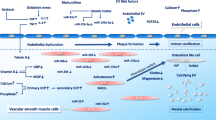Abstract
Experimental animal model studies suggest that calcium oxalate (CaOx) crystal deposition in the kidneys is associated with the development of oxidative stress, epithelial injury and inflammation. There is increased production of inflammatory molecules including osteopontin (OPN), monocyte chemoattractant protein-1 (MCP-1) and various subunits of inter-alpha-inhibitor such as bikunin. What does the increased production of such molecules suggest? Is it a cause or consequence of crystal deposition? We hypothesized that over-expression and increased production of MCP-1 is a result of the interaction between renal epithelial cells and CaOx crystals after their deposition in the renal tubules. We induced hyperoxaluria in MCP-1 null as well as wild type mice and examined pathological changes in their kidneys and urine. Both wild type and MCP-1 null male mice became hyperoxaluric and demonstrated CaOx crystalluria. Neither of them developed crystal deposits in their kidneys. Both showed some morphological changes in their renal proximal tubules. Significant pathological changes such as cell death and increased urinary excretion of LDH were not seen. Results suggest that at least in mice (1) Increase in oxalate and decrease in citrate excretion can lead to CaOx crystalluria but not CaOx nephrolithiasis; (2) MCP-1 does not play a role in crystal retention within the kidneys; (3) Expression of OPN and MCP-1 is not increased in the kidneys in the absence of crystal deposition; (4) Crystal deposition is necessary for significant pathological changes and movement of monocytes and macrophages into the interstitium.



Similar content being viewed by others
References
Boonla C, Hunapathed C, Bovornpadungkitti S, Poonpirome K, Tungsanga K, Sampatanukul P, Tosukhowong P (2008) Messenger RNA expression of monocyte chemoattractant protein-1 and interleukin-6 in stone-containing kidneys. BJU Int 101:1170–1177
Chau H, El-Maadawy S, McKee MD, Tenenhouse HS (2003) Renal calcification in mice homozygous for the disrupted type IIa Na/Pi cotransporter gene Npt2. J Bone Miner Res 18:644–657
de Water R, Noordermeer C, van der Kwast TH, Nizze H, Boeve ER, Kok DJ, Schroder FH (1999) Calcium oxalate nephrolithiasis: effect of renal crystal deposition on the cellular composition of the renal interstitium. Am J Kidney Dis 33:761–771
Khan SR (1995) Calcium oxalate crystal interaction with renal tubular epithelium, mechanism of crystal adhesion and its impact on stone development. Urol Res 23:71–79
Khan SR (1997) Animal models of kidney stone formation: an analysis. World J Urol 15:236–243
Khan SR (2004) Crystal-induced inflammation of the kidneys: results from human studies, animal models, and tissue-culture studies. Clin Exp Nephrol 8:75–88
Khan SR, Finlayson B, Hackett RL (1982) Experimental calcium oxalate nephrolithiasis in the rat. Role of the renal papilla. Am J Pathol 107:59–69
Khan SR, Glenton PA (2008) Calcium oxalate crystal deposition in kidneys of hypercalciuric mice with disrupted type IIa sodium-phosphate cotransporter. Am J Physiol Renal Physiol 294:F1109–F1115
Khan SR, Kok DJ (2004) Modulators of urinary stone formation. Front Biosci 9:1450–1482
Mazzali M, Kipari T, Ophascharoensuk V, Wesson JA, Johnson R, Hughes J (2002) Osteopontin—a molecule for all seasons. QJM 95:3–13
McKee MD, Nanci A, Khan SR (1995) Ultrastructural immunodetection of osteopontin and osteocalcin as major matrix components of renal calculi. J Bone Miner Res 10:1913–1929
Mo L, Liaw L, Evan AP, Sommer AJ, Lieske JC, Wu XR (2007) Renal calcinosis and stone formation in mice lacking osteopontin, Tamm-Horsfall protein, or both. Am J Physiol Renal Physiol 293:F1935–F1943
Moe OW, Bonny O (2005) Genetic hypercalciuria. J Am Soc Nephrol 16:729–745
Okada A, Nomura S, Higashibata Y, Hirose M, Gao B, Yoshimura M, Itoh Y, Yasui T, Tozawa K, Kohri K (2007) Successful formation of calcium oxalate crystal deposition in mouse kidney by intraabdominal glyoxylate injection. Urol Res 35:89–99
Ryall RL (2004) Macromolecules and urolithiasis: parallels and paradoxes. Nephron Physiol 98:37–42
Sakhaee K (2008) Nephrolithiasis as a systemic disorder. Curr Opin Nephrol Hypertens 17:304–309
Toblli JE, Ferder L, Stella I, Angerosa M, Inserra F (2002) Enalapril prevents fatty liver in nephrotic rats. J Nephrol 15:358–367
Toblli JE, Ferder L, Stella I, De Cavanaugh EM, Angerosa M, Inserra F (2002) Effects of angiotensin II subtype 1 receptor blockade by losartan on tubulointerstitial lesions caused by hyperoxaluria. J Urol 168:1550–1555
Umekawa T, Chegini N, Khan SR (2002) Oxalate ions and calcium oxalate crystals stimulate MCP-1 expression by renal epithelial cells. Kidney Int 61:105–112
Umekawa T, Hatanaka Y, Kurita T, Khan SR (2004) Effect of angiotensin II receptor blockage on osteopontin expression and calcium oxalate crystal deposition in rat kidneys. J Am Soc Nephrol 15:635–644
Umekawa T, Iguchi M, Uemura H, Khan SR (2006) Oxalate ions and calcium oxalate crystal-induced up-regulation of osteopontin and monocyte chemoattractant protein-1 in renal fibroblasts. BJU Int 98:656–660
Verkoelen CF, van der Boom BG, Houtsmuller AB, Schroder FH, Romijn JC (1998) Increased calcium oxalate monohydrate crystal binding to injured renal tubular epithelial cells in culture. Am J Physiol 274:F958–F965
Weinman EJ, Mohanlal V, Stoycheff N, Wang F, Steplock D, Shenolikar S, Cunningham R (2006) Longitudinal study of urinary excretion of phosphate, calcium, and uric acid in mutant NHERF-1 null mice. Am J Physiol Renal Physiol 290:F838–F843
Wesson JA, Johnson RJ, Mazzali M, Beshensky AM, Stietz S, Giachelli C, Liaw L, Alpers CE, Couser WG, Kleinman JG, Hughes J (2003) Osteopontin is a critical inhibitor of calcium oxalate crystal formation and retention in renal tubules. J Am Soc Nephrol 14:139–147
Author information
Authors and Affiliations
Corresponding author
Rights and permissions
About this article
Cite this article
Khan, S.R., Glenton, P.A. Experimentally induced hyperoxaluria in MCP-1 null mice. Urol Res 39, 253–258 (2011). https://doi.org/10.1007/s00240-010-0345-7
Received:
Accepted:
Published:
Issue Date:
DOI: https://doi.org/10.1007/s00240-010-0345-7




